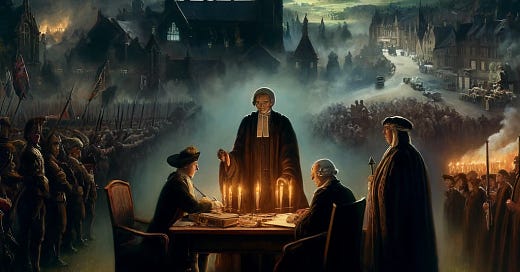Nestled in the heart of Perthshire, the town of Auchterarder is quiet today—a peaceful place of scenic hills, golf courses, and charming cottages. But hidden beneath its tranquil surface is a history that reads like a theological thriller. Over the span of nearly three centuries, Auchterarder was at the epicenter of three seismic shifts in the religious life of Scotland:
The Treaty of Auchterarder in 1559, which marked the first state recognition of Protestantism.
The Auchterarder Creed in 1717, which ignited the rise of the Secession Church.
The Veto Act controversy in 1834, which sparked the Disruption of 1843, one of the most dramatic schisms in Scottish ecclesiastical history.
Coincidence? Fate? Divine appointment? Or something stranger still?
This article dives into each of these turning points and asks: Is Auchterarder cursed with religious conflict—or chosen to be a catalyst of transformation?
1. The Treaty of Auchterarder (1559): The Spark of Reformation
In the thick of the Scottish Reformation, John Knox had just preached a thunderous sermon in Perth that led to riots and the destruction of Catholic institutions. Tensions between Protestant reformers and Queen Regent Mary of Lorraine escalated rapidly, with both sides mustering troops for a potential civil clash.
With her forces camped at Auchterarder, Mary attempted diplomacy to avert open war. Protestant envoys—including Erskine of Dun—met with her representatives, and on May 29, 1559, the Treaty of Auchterarder was signed.
It was modest in content—mainly about troop withdrawals and safety guarantees—but symbolically massive. It was the first time the Protestant cause was given political legitimacy in Scotland. Though the treaty was short-lived and not strictly observed, it marked a shift: Protestantism had entered the realm of official negotiation.
And where did it happen? Auchterarder.
This wasn’t just another town—it was the stage for one of the earliest recognitions of Protestant legitimacy in the British Isles.
2. The Auchterarder Creed (1717): The Heresy That Built a Church
Fast forward over 150 years, and once again Auchterarder would find itself at the heart of ecclesiastical drama.
In 1717, a theological controversy erupted in the Presbytery of Auchterarder. The flashpoint? A candidate for ministry was asked to affirm the following proposition:
“It is not sound or orthodox to teach that we must forsake sin in order to come to Christ.”
This odd-sounding statement became known as the Auchterarder Creed.
At first glance, it might seem like obscure theological hairsplitting, but it raised major questions: Does repentance precede salvation? Or is it a result of grace? The General Assembly of the Church of Scotland condemned the statement, but the damage was done.
The controversy lit the fuse that would eventually lead to the rise of the Secession Church in 1732, when ministers like Ebenezer Erskine (yes, another Erskine!) broke away from the established Church over issues of patronage and doctrinal purity.
And again, the catalyst was a local dispute in Auchterarder.
3. The Veto Act Controversy (1834–1843): The Great Disruption Begins
By the 19th century, Scotland had long been a Presbyterian nation—but not a peaceful one. The right of local congregations to choose their ministers (as opposed to landowning patrons appointing them) had become a growing concern.
In 1834, the General Assembly passed the Veto Act, which gave congregations the power to reject a patron's nominee if a majority opposed him.
This progressive move ran headfirst into the legal reality of the time. When the Presbytery of Auchterarder refused to induct a patron-appointed minister (James Young), the patron sued—and won. The Court of Session ruled that the Presbytery had acted illegally.
This ruling wasn’t just a legal dispute. It sent shockwaves through the Church of Scotland, raising urgent questions about the independence of the Church from state interference. The conflict escalated, and in 1843, nearly 40% of ministers left the established Church in what became known as The Disruption—founding the Free Church of Scotland.
Once again, the event that set the whole chain in motion happened in Auchterarder.
Coincidence… or Calling?
So, what’s the deal with Auchterarder?
Why would a small, relatively remote town be the setting for three watershed moments in Scottish religious history?
Here are a few possible explanations:
Historical Geography
Auchterarder’s location in central Scotland, not far from Perth and Stirling, made it accessible to major political and religious figures. It was central enough to matter—but peripheral enough to allow for experimentation and dissent.
Strong Local Clergy
From Erskines to evangelicals, Auchterarder has often been home to passionate, theologically-minded ministers. The presbytery here seems to have had a tradition of standing firm on matters of conscience—even when it meant clashing with Church or Crown.
A Legacy of Defiance
After being the site of the 1559 treaty, Auchterarder may have developed a local identity as a place where resistance and reform were not only possible but expected. Each generation carried the torch of challenge forward—sometimes theological, sometimes political, always consequential.
Theological Fault Lines
Scotland's religious history has always been about more than just doctrine—it’s about freedom, sovereignty, and the soul of the nation. Auchterarder became a symbolic battleground for these struggles, again and again.
Cursed or Chosen?
Is Auchterarder cursed to repeat conflict? Or chosen to lead the way?
Maybe it’s neither. Maybe it’s simply a place where conviction runs deep—and when conviction meets power, something always breaks.
But it is undeniably strange that this one small town—barely a footnote in most histories—has played such an outsized role in Scotland’s religious transformation.
It stood at the edge of war during the Reformation.
It spoke the heresy that birthed a new church.
It triggered a court case that broke the national one.
If places carry memory—and if memory shapes destiny—then Auchterarder might not be cursed or chosen, but rather called. Called to witness, to challenge, and to remind us that sometimes the biggest changes begin in the smallest towns.





